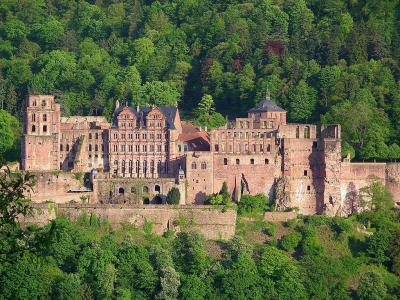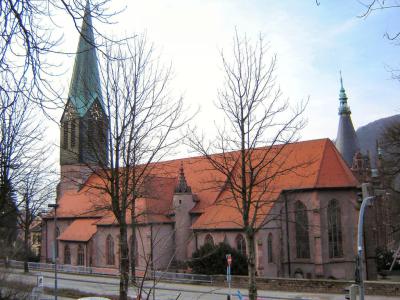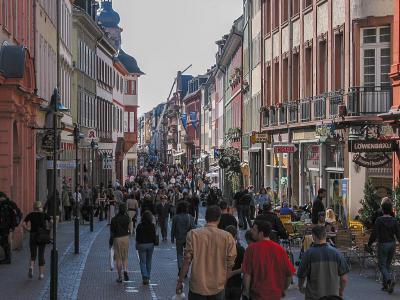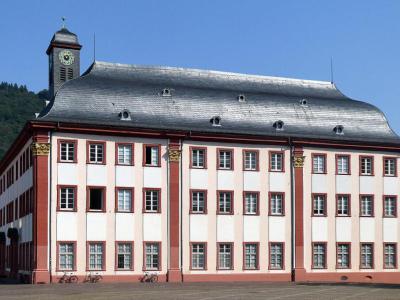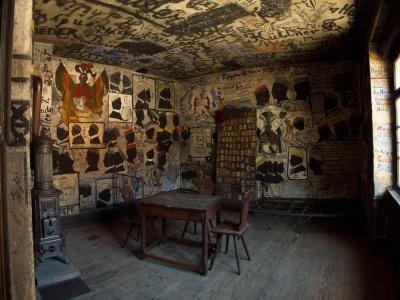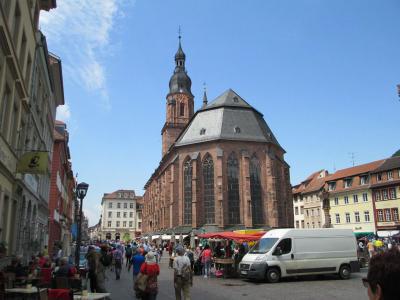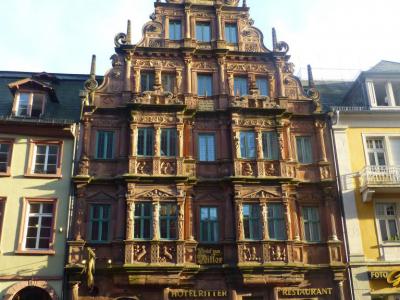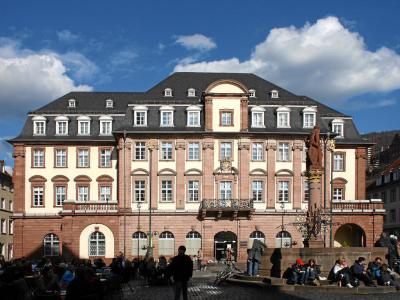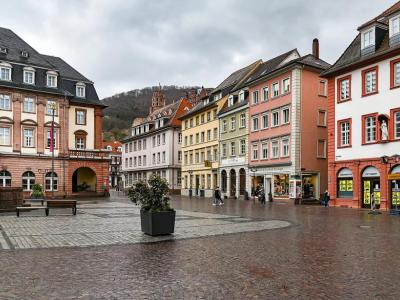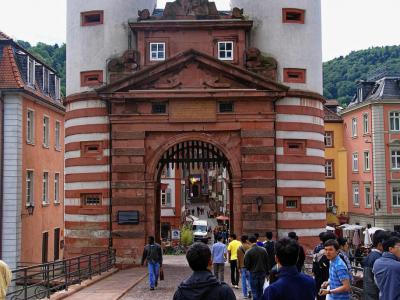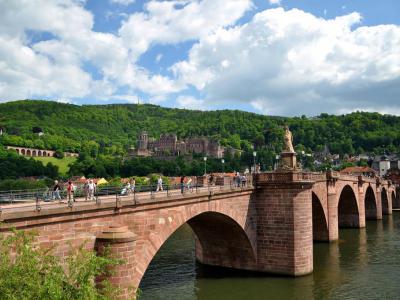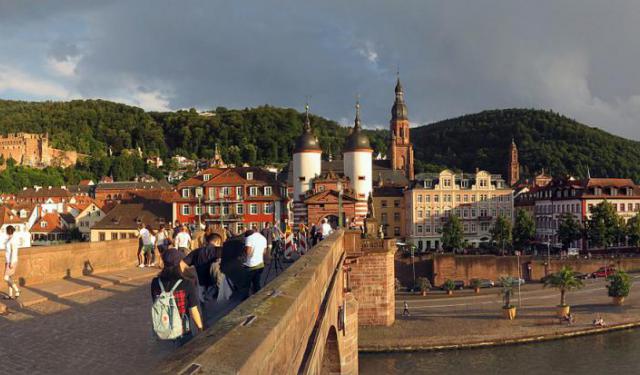
Heidelberg Introduction Walking Tour (Self Guided), Heidelberg
Heidelberg is located on the Neckar River and is Baden-Württemberg’s fifth-largest city. One-quarter of the approximately 160,000 residents are students. Heidelberg University was founded in 1386 and is Germany’s oldest and one of Europe’s most prestigious universities. In addition, Heidelberg is home to internationally acclaimed research facilities, including four Max Planck Institutes. The UNESCO Creative Cities Network named Heidelberg a “City of Literature.”
Heidelberg has been a center of human habitation for millennia. In 1907, a jawbone from an ancient human was discovered nearby and is Europe’s earliest human artifact. A Celtic fortress was built in Heidelberg in the 5th century BC. The Romans built a wooden bridge and occupied the area from 40 AD to 260 AD.
The Bergheim village was established around 769 AD. Modern Heidelberg can be traced to the founding of the 12th-century Schonau Abbey. Throughout medieval times, Heidelberg was the seat of the Electorate of the Palatinate.
Heidelberg was involved in the damaging Thirty Years’ War from 1618 to 1648. This war was fought as part of the European wars of religion. The struggle was between Lutheran and Catholic states and a fight between Austria, Spain, and France for European domination. Heidelberg was sieged by enemy forces in 1622. The war finally ended when the Peace of Westphalia treaties were signed in 1648.
During the Nine Years’ War from 1688 to 1697, French troops attacked the Electoral Palatinate. Heidelberg Castle was set on fire twice during the Nine Years’ War. Heidelberg Castle remains in ruins but this beautiful location is Heidelberg’s top tourist destination.
The 1693 fire damaged most of Heidelberg’s buildings. The House of the Knight, originally built in 1592, was one of the few buildings that survived. The famous French writer Victor Hugo was particularly impressed by its beauty during his stay in Heidelberg in 1838. So will you.
Today’s visitors can explore Heidelberg University’s history by visiting the Old University Building and the Student Prison. Visit St. Peter’s Church and the Church of the Holy Spirit to immerse yourself in Heidelberg’s long religious history. Heidelberg is known for its cultural and community events, and its Main Street is one of Europe's oldest shopping streets.
Take this self-guided tour to explore Heidelberg’s most notable sights.
Heidelberg has been a center of human habitation for millennia. In 1907, a jawbone from an ancient human was discovered nearby and is Europe’s earliest human artifact. A Celtic fortress was built in Heidelberg in the 5th century BC. The Romans built a wooden bridge and occupied the area from 40 AD to 260 AD.
The Bergheim village was established around 769 AD. Modern Heidelberg can be traced to the founding of the 12th-century Schonau Abbey. Throughout medieval times, Heidelberg was the seat of the Electorate of the Palatinate.
Heidelberg was involved in the damaging Thirty Years’ War from 1618 to 1648. This war was fought as part of the European wars of religion. The struggle was between Lutheran and Catholic states and a fight between Austria, Spain, and France for European domination. Heidelberg was sieged by enemy forces in 1622. The war finally ended when the Peace of Westphalia treaties were signed in 1648.
During the Nine Years’ War from 1688 to 1697, French troops attacked the Electoral Palatinate. Heidelberg Castle was set on fire twice during the Nine Years’ War. Heidelberg Castle remains in ruins but this beautiful location is Heidelberg’s top tourist destination.
The 1693 fire damaged most of Heidelberg’s buildings. The House of the Knight, originally built in 1592, was one of the few buildings that survived. The famous French writer Victor Hugo was particularly impressed by its beauty during his stay in Heidelberg in 1838. So will you.
Today’s visitors can explore Heidelberg University’s history by visiting the Old University Building and the Student Prison. Visit St. Peter’s Church and the Church of the Holy Spirit to immerse yourself in Heidelberg’s long religious history. Heidelberg is known for its cultural and community events, and its Main Street is one of Europe's oldest shopping streets.
Take this self-guided tour to explore Heidelberg’s most notable sights.
How it works: Download the app "GPSmyCity: Walks in 1K+ Cities" from Apple App Store or Google Play Store to your mobile phone or tablet. The app turns your mobile device into a personal tour guide and its built-in GPS navigation functions guide you from one tour stop to next. The app works offline, so no data plan is needed when traveling abroad.
Heidelberg Introduction Walking Tour Map
Guide Name: Heidelberg Introduction Walking Tour
Guide Location: Germany » Heidelberg (See other walking tours in Heidelberg)
Guide Type: Self-guided Walking Tour (Sightseeing)
# of Attractions: 11
Tour Duration: 2 Hour(s)
Travel Distance: 2.0 Km or 1.2 Miles
Author: Caroline
Sight(s) Featured in This Guide:
Guide Location: Germany » Heidelberg (See other walking tours in Heidelberg)
Guide Type: Self-guided Walking Tour (Sightseeing)
# of Attractions: 11
Tour Duration: 2 Hour(s)
Travel Distance: 2.0 Km or 1.2 Miles
Author: Caroline
Sight(s) Featured in This Guide:
- Schloss Heidelberg (Heidelberg Castle)
- St. Peter's Church
- Heidelberg's Hauptstrasse (Main Street)
- Alte Universität (Old University Building)
- Studentenkarzer (Student Prison)
- Church of the Holy Spirit
- Haus zum Ritter (House of the Knights)
- Town Hall
- Marktplat (Market Square)
- Bruckentor (Bridge Gate)
- Old Bridge (Carl Theodor Bridge)
1) Schloss Heidelberg (Heidelberg Castle) (must see)
Heidelberg Castle is Heidelberg's most impressive landmark and one of Germany's most popular castles. This stunning castle is situated on a hill 300 feet above Heidelberg. The castle was built over different periods of German history and has a haphazard look. The castle features many buildings constructed around a central courtyard.
Building first began around 1300, and Prince Elector Ruprecht III was the castle's first royal resident in the early 1400s. The castle was damaged by fire twice during the Nine Years’ War -- first in 1689, and again in 1693. In 1697, the treaty of Ryswick was signed and the war ended. However, the castle needed extensive repair before it can be used again. In 1720, the court moved to Mannheim.
Karl Theodor planned to move the court back to Heidelberg Castle. However, the castle was hit by two lightning strikes on June 24, 1764, and the castle was further damaged by fire. Karl Theodor saw the lightning strikes and fire as a sign from heaven and abandoned his plans to move back into the castle.
In the early 1800s, Count Charles de Graimberg started leading a movement to preserve the castle’s ruins and prevent further decay.
The castle affords wonderful views of Heidelberg old town, the Neckar valley and river. In addition, the castle is a popular place to get married.
The castle gardens were first built in the early 1600s by Prince Elector Friedrich V as a gift for his wife, Elizabeth. These gardens were a masterpiece and featured mazes, flower beds, sculptures, waterfalls, ponds, and a grotto. Sadly, the gardens were destroyed during the Nine Years’ War in 1693.
Another don't miss feature is the Heidelberg Tun, also known as the "World's Largest Wine Barrel." This barrel was built in 1751 to store the wine paid as taxes by local winemakers. This massive barrel holds 58,124 gallons of wine and has a dance floor on top of the barrel.
The Otto Heirich Building houses the Apothecary Museum. This museum features exhibits on the history of dispensaries and pharmacies and gives visitors an insight into medicine in the 17th, 18th, and 19th centuries.
The castle hosts an impressive fireworks display three times every summer. The fireworks display memorializes the three times that fire affected the castle. Two of the fires occurred during wars with the French, and the final fire was caused by lightning.
Building first began around 1300, and Prince Elector Ruprecht III was the castle's first royal resident in the early 1400s. The castle was damaged by fire twice during the Nine Years’ War -- first in 1689, and again in 1693. In 1697, the treaty of Ryswick was signed and the war ended. However, the castle needed extensive repair before it can be used again. In 1720, the court moved to Mannheim.
Karl Theodor planned to move the court back to Heidelberg Castle. However, the castle was hit by two lightning strikes on June 24, 1764, and the castle was further damaged by fire. Karl Theodor saw the lightning strikes and fire as a sign from heaven and abandoned his plans to move back into the castle.
In the early 1800s, Count Charles de Graimberg started leading a movement to preserve the castle’s ruins and prevent further decay.
The castle affords wonderful views of Heidelberg old town, the Neckar valley and river. In addition, the castle is a popular place to get married.
The castle gardens were first built in the early 1600s by Prince Elector Friedrich V as a gift for his wife, Elizabeth. These gardens were a masterpiece and featured mazes, flower beds, sculptures, waterfalls, ponds, and a grotto. Sadly, the gardens were destroyed during the Nine Years’ War in 1693.
Another don't miss feature is the Heidelberg Tun, also known as the "World's Largest Wine Barrel." This barrel was built in 1751 to store the wine paid as taxes by local winemakers. This massive barrel holds 58,124 gallons of wine and has a dance floor on top of the barrel.
The Otto Heirich Building houses the Apothecary Museum. This museum features exhibits on the history of dispensaries and pharmacies and gives visitors an insight into medicine in the 17th, 18th, and 19th centuries.
The castle hosts an impressive fireworks display three times every summer. The fireworks display memorializes the three times that fire affected the castle. Two of the fires occurred during wars with the French, and the final fire was caused by lightning.
2) St. Peter's Church
St. Peter's Church is Heidelberg's oldest church. It was originally built during the 12th century in the Romanesque style. St. Peter's Church was originally a parish church. It became a collegiate church in 1400. The church was renovated in 1489, and a chapel and Gothic-style tower were added.
St. Peter's Church was destroyed during the Nine Years’ War. The church was rebuilt in the Baroque style during the 18th century and then rebuilt in a neo-Gothic style from 1863 to 1870. Since 1896, the church has functioned as a university church.
St. Peter's Church has an ancient cemetery with graves and monuments that are over 500 years old. One of the most famous graves belongs to the poet Olympia Fulvia Morata who died in 1555. The church has 90 epitaphs inside and 66 epitaphs on the outside walls.
The church had a major interior renovation between 2004 and 2005 and recently installed modern church windows designed by Johannes Schreiter.
St. Peter's Church regularly holds panel discussions, exhibitions, and concerts.
St. Peter's Church was destroyed during the Nine Years’ War. The church was rebuilt in the Baroque style during the 18th century and then rebuilt in a neo-Gothic style from 1863 to 1870. Since 1896, the church has functioned as a university church.
St. Peter's Church has an ancient cemetery with graves and monuments that are over 500 years old. One of the most famous graves belongs to the poet Olympia Fulvia Morata who died in 1555. The church has 90 epitaphs inside and 66 epitaphs on the outside walls.
The church had a major interior renovation between 2004 and 2005 and recently installed modern church windows designed by Johannes Schreiter.
St. Peter's Church regularly holds panel discussions, exhibitions, and concerts.
3) Heidelberg's Hauptstrasse (Main Street)
Heidelberg Main Street is one of Europe's oldest, longest, and most popular shopping streets. This pedestrian street runs 1.8 kilometers (1.12 miles) from one end of Old Town to the other. Main Street is home to several historic landmark buildings, including City Hall, the Church of the Holy Spirit, and the House of the Knights.
The street runs through a traffic route that was used even before the city was founded during the 13th century. The street expanded in the 14th century to its current length and had a gate at each end.
Visitors can see the Karlstor gate at the eastern end. The Karlstor replaced the original gate in the 1700s and resembles a Roman triumphal arch. The gate is protected by two lion statues. In addition, visitors can see the elector's coat of arms on the gate.
If you like to shop, you'll love Main Street. You can find anything you are looking for along this historic street. Shoppers will find a mix of international and regional brands and small boutiques selling clothes, accessories, souvenirs, knick-knacks, and more. Main Street is also home to chocolate shops, flower shops, and a wonderful antique bookstore.
One can find dozens of fabulous restaurants, cafes, and bars on Main Street. There are international cuisines such as Japanese, Italian, Mexican, and American. You can also find fast-food chains like Pizza Hut and Subway. Many restaurants have outdoor seating so you can enjoy people-watching and ponder your next purchase while you dine.
Main Street hosts a fabulous Christmas Market which features an ice rink. It also hosts concerts and arts and crafts markets throughout the year.
The street runs through a traffic route that was used even before the city was founded during the 13th century. The street expanded in the 14th century to its current length and had a gate at each end.
Visitors can see the Karlstor gate at the eastern end. The Karlstor replaced the original gate in the 1700s and resembles a Roman triumphal arch. The gate is protected by two lion statues. In addition, visitors can see the elector's coat of arms on the gate.
If you like to shop, you'll love Main Street. You can find anything you are looking for along this historic street. Shoppers will find a mix of international and regional brands and small boutiques selling clothes, accessories, souvenirs, knick-knacks, and more. Main Street is also home to chocolate shops, flower shops, and a wonderful antique bookstore.
One can find dozens of fabulous restaurants, cafes, and bars on Main Street. There are international cuisines such as Japanese, Italian, Mexican, and American. You can also find fast-food chains like Pizza Hut and Subway. Many restaurants have outdoor seating so you can enjoy people-watching and ponder your next purchase while you dine.
Main Street hosts a fabulous Christmas Market which features an ice rink. It also hosts concerts and arts and crafts markets throughout the year.
4) Alte Universität (Old University Building) (must see)
Heidelberg University was founded in 1386 on instruction of Pope Urban VI and is Germany's oldest university and one of the oldest surviving universities in the world. Over thirty Nobel Prize winners have been affiliated with the university in its history.
The Old University Building was built between 1712 and 1728. It was named "Wilhelm's House" to honor Elector Johann Wilhelm.
The Old University Building houses the university museum and the Rector's Office, and the historic student prison can be seen at the back of the building.
The Great Hall is located on the first floor and is a dramatic example of the university's heritage. The hall was renovated in 1886 to celebrate the university's 500th anniversary.
The Great Hall features busts and paintings honoring university founders, academics, benefactors, and innovators. This impressive space is used for academic ceremonies, celebrations, lectures, and concerts.
The university museum features exhibits celebrating Germany's oldest university. Exhibits begin with the university's 1386 founding and walk visitors through the university's history.
For centuries the lion fountain in front of the building's western facade was one of Heidelberg's most important drinking water sources for local population.
The Old University Building was built between 1712 and 1728. It was named "Wilhelm's House" to honor Elector Johann Wilhelm.
The Old University Building houses the university museum and the Rector's Office, and the historic student prison can be seen at the back of the building.
The Great Hall is located on the first floor and is a dramatic example of the university's heritage. The hall was renovated in 1886 to celebrate the university's 500th anniversary.
The Great Hall features busts and paintings honoring university founders, academics, benefactors, and innovators. This impressive space is used for academic ceremonies, celebrations, lectures, and concerts.
The university museum features exhibits celebrating Germany's oldest university. Exhibits begin with the university's 1386 founding and walk visitors through the university's history.
For centuries the lion fountain in front of the building's western facade was one of Heidelberg's most important drinking water sources for local population.
5) Studentenkarzer (Student Prison)
The University of Heidelberg was founded in 1386. By the 16th century, city residents started complaining about university student antics, and the university decided to install a university prison to keep troublemakers off the streets for a few days. The student prison moved around between several locations.
The student prison currently open to visitors was used from 1823 to 1914. Students were incarcerated for offenses such as disturbing the peace, drunkenness, womanizing, and setting townspeople's pigs free.
Students were incarcerated between two days and four weeks, depending on the offense. The prison is the size of an apartment, and prisoners almost coveted a stay in the prison. In fact, it was even considered a rite of passage and a point of pride.
Technically, students were allowed to attend lectures during their time in prison, but most students preferred to skip class. Instead, student prisoners spent their time drawing on the walls and crafting poems. This marvelous graffiti is on walls, above doors, and on the ceiling.
The student prison currently open to visitors was used from 1823 to 1914. Students were incarcerated for offenses such as disturbing the peace, drunkenness, womanizing, and setting townspeople's pigs free.
Students were incarcerated between two days and four weeks, depending on the offense. The prison is the size of an apartment, and prisoners almost coveted a stay in the prison. In fact, it was even considered a rite of passage and a point of pride.
Technically, students were allowed to attend lectures during their time in prison, but most students preferred to skip class. Instead, student prisoners spent their time drawing on the walls and crafting poems. This marvelous graffiti is on walls, above doors, and on the ceiling.
6) Church of the Holy Spirit
The Church of the Holy Spirit is Heidelberg's largest church. It is one of Germany's most visited churches and receives between one million and three million visitors a year.
The Church of the Holy Spirit was initially a parish church that was built in 1239. Elector Ruprecht III ordered a more magnificent church to be constructed along with the new university, and construction began in 1378.
In 1386, the church hosted a special mass to celebrate Heidelberg University's founding. In those days, the church was used for services as well as the university's first lectures.
The Church of the Holy Spirit was originally built to serve as a burial place for the Electors and the Palatine royal seat.
The current church was built between 1378 and 1515 and features Romanesque and Gothic architecture. Elector Ludwig III founded the Palatinate library in the church in the 1400s.
Unfortunately, during the Thirty Years' War, the extensive and valuable library collection was plundered. In addition, the church was set on fire and almost destroyed in 1633. After the war, the church was rebuilt with a Baroque-style roof.
During the Nine Years’ War, many of the original graves were destroyed. However, the grave of Elector Ruprecht III, the church's founder, remains.
In 1706, a partition was built so that both Protestants and Catholics could worship in the church. The partition was torn down in 1936.
Today's visitors can climb the steeple for a wonderful view of Heidelberg Old Town.
The Church of the Holy Spirit was initially a parish church that was built in 1239. Elector Ruprecht III ordered a more magnificent church to be constructed along with the new university, and construction began in 1378.
In 1386, the church hosted a special mass to celebrate Heidelberg University's founding. In those days, the church was used for services as well as the university's first lectures.
The Church of the Holy Spirit was originally built to serve as a burial place for the Electors and the Palatine royal seat.
The current church was built between 1378 and 1515 and features Romanesque and Gothic architecture. Elector Ludwig III founded the Palatinate library in the church in the 1400s.
Unfortunately, during the Thirty Years' War, the extensive and valuable library collection was plundered. In addition, the church was set on fire and almost destroyed in 1633. After the war, the church was rebuilt with a Baroque-style roof.
During the Nine Years’ War, many of the original graves were destroyed. However, the grave of Elector Ruprecht III, the church's founder, remains.
In 1706, a partition was built so that both Protestants and Catholics could worship in the church. The partition was torn down in 1936.
Today's visitors can climb the steeple for a wonderful view of Heidelberg Old Town.
7) Haus zum Ritter (House of the Knights)
The House of the Knights is Heidelberg's oldest surviving residential building. It was originally built in 1592 by Charles Belier. The renaissance building was constructed with stone and is the only residential building that survived the 1693 fire. Since it was one of the few remaining buildings, it served as the town hall from 1693 to 1703.
The house has several Latin inscriptions. One says “May beauty remain undefeated.” Another is translated as "Glory to God alone." The longer inscription can be translated as "Unless the Lord builds the house, the builders work in vain."
The house also has a ram symbol above the entrance. The ram symbol represents the Belier family, as "belier" is the French word for ram.
Famous French writer Victor Hugo visited the house in 1838 and was impressed by its survival and beauty.
The House of the Knights has been used for various purposes over the centuries. Three hundred years ago, it was used as an inn. Today, it is again used as a hotel.
The house has several Latin inscriptions. One says “May beauty remain undefeated.” Another is translated as "Glory to God alone." The longer inscription can be translated as "Unless the Lord builds the house, the builders work in vain."
The house also has a ram symbol above the entrance. The ram symbol represents the Belier family, as "belier" is the French word for ram.
Famous French writer Victor Hugo visited the house in 1838 and was impressed by its survival and beauty.
The House of the Knights has been used for various purposes over the centuries. Three hundred years ago, it was used as an inn. Today, it is again used as a hotel.
8) Town Hall
The original town hall was destroyed during the Nine Years’ War in 1689. A Baroque-style town hall was completed in 1703, and Hungarian sculptor Heinrich Charrasky added the electoral coat of arms.
The Renaissance north wing was completed in 1890. This main hall features paintings by artist Karl Hoffacker depicting the history of the Electoral Palatinate.
A fire damaged the town hall in 1908. After the fire, a Baroque south wing was added. The bell tower was added to the east facade in 1961.
Today, the town hall houses the Mayor's offices, and town councilors meet here.
The town hall plays an integral part in Heidelberg's Christmas Market. Every year, a Christ child stands on Town Hall's balcony and officially opens the Christmas Market. During the holidays, the hall's facade is illuminated with festive motifs.
The Renaissance north wing was completed in 1890. This main hall features paintings by artist Karl Hoffacker depicting the history of the Electoral Palatinate.
A fire damaged the town hall in 1908. After the fire, a Baroque south wing was added. The bell tower was added to the east facade in 1961.
Today, the town hall houses the Mayor's offices, and town councilors meet here.
The town hall plays an integral part in Heidelberg's Christmas Market. Every year, a Christ child stands on Town Hall's balcony and officially opens the Christmas Market. During the holidays, the hall's facade is illuminated with festive motifs.
9) Marktplat (Market Square) (must see)
Market Square is one of Heidelberg's oldest squares and is a lively area with shops, restaurants, and historic buildings. Market Square is dominated by the impressive Church of the Holy Spirit. The square is also home to Town Hall and several residences.
For centuries, the square has been used for a weekly market. Public trials were also held in Market Square. Heretics and those accused of being witches were burned at the stake in the square. Those charged with lesser crimes were imprisoned in cages and publicly humiliated.
In the center of the square, visitors will find the Hercules Fountain, which was completed in 1709. The fountain features a Hercules figure on a tall column and commemorates Heidelberg's rebuilding efforts after the devasting Nine Years’ War.
The square has many restaurants and cafes with delightful outdoor seating, so you can enjoy the square's lively ambiance.
The square is home to the popular Heidelberg Christmas Market. Visitors can find holiday gifts, delicious treats, and enjoy the festive decorations.
For centuries, the square has been used for a weekly market. Public trials were also held in Market Square. Heretics and those accused of being witches were burned at the stake in the square. Those charged with lesser crimes were imprisoned in cages and publicly humiliated.
In the center of the square, visitors will find the Hercules Fountain, which was completed in 1709. The fountain features a Hercules figure on a tall column and commemorates Heidelberg's rebuilding efforts after the devasting Nine Years’ War.
The square has many restaurants and cafes with delightful outdoor seating, so you can enjoy the square's lively ambiance.
The square is home to the popular Heidelberg Christmas Market. Visitors can find holiday gifts, delicious treats, and enjoy the festive decorations.
10) Bruckentor (Bridge Gate)
Bridge Gate has guarded the way to Heidelberg's north entrance for centuries. Bridge Gate was originally part of the city's walls, and the two towers date to the 15th century. This medieval gate has survived the ice floes and fires that damaged the previous bridges.
The gate has served many functions over the centuries. As part of the city's defenses, the gate could easily be closed in case of attack. The bridge gate also served as a tollhouse, and foreigners wanting to cross the bridge would have to pay a toll. In addition, Bridge Gate has served as a guardhouse and a jail.
The towers are 28 meters high (92 feet). The eastern tower has a spiral staircase that leads to living quarters that were the bridge keeper's home. The western tower has three rooms that were used as detention rooms. The original gate tower tops were replaced with Baroque-style spires in 1788.
Near the gate, you can see flood marks from various floods.
The gate has served many functions over the centuries. As part of the city's defenses, the gate could easily be closed in case of attack. The bridge gate also served as a tollhouse, and foreigners wanting to cross the bridge would have to pay a toll. In addition, Bridge Gate has served as a guardhouse and a jail.
The towers are 28 meters high (92 feet). The eastern tower has a spiral staircase that leads to living quarters that were the bridge keeper's home. The western tower has three rooms that were used as detention rooms. The original gate tower tops were replaced with Baroque-style spires in 1788.
Near the gate, you can see flood marks from various floods.
11) Old Bridge (Carl Theodor Bridge) (must see)
The Old Bridge spans the Neckar river and connects the old city with the newer eastern part of Heidelberg.
The Old Bridge was built in 1788 and is actually one of Heidelberg's newer structures. There have been eight bridges here throughout history, and the current bridge was built on the previous bridge's foundations. The bridge was previously known as Carl Theodor Bridge. When the Theodor Heuss Bridge was built in 1877, the Carl Theodor Bridge became known as the "Old Bridge."
Romans built the first bridge across the river during the first century. The Roman bridge collapsed, and it took nearly a thousand years to replace it.
A bridge was again built during the 12th or 13th century when Heidelberg was founded. This bridge was located where the current bridge stands and was aligned with the marketplace.
In Heidelberg's early days, the bridge marked the border with the Electorate of Mainz and served as part of Heidelberg's defenses.
Ice floes destroyed several of the bridge's early versions. The seventh bridge survived the Thirty Years' War but was destroyed during the Nine Years' War. Residents then used ferries and pontoon bridges for twenty years.
The current nine-arch bridge was built with distinctive red sandstone. The Old Bridge has an ancient gate and two towers in addition to statues of Prince Karl-Theodor and Minerva. Unfortunately, the bridge was damaged during World War II, and three of the arches were destroyed. The bridge was rebuilt after the war.
The Heidelberg Bridge Monkey is a popular tourist attraction. A monkey statue has been a part of the bridge since the 15th century. The original statue disappeared during the Nine Years' War and was replaced.
The current statue depicts a monkey holding a mirror with one hand and making the sign of the horns with the other hand. Tourists often place their heads inside the monkey's head. Rubbing the monkey's mirror is supposed to bring luck, while touching the fingers ensures visitors will return to Heidelberg.
The Old Bridge was built in 1788 and is actually one of Heidelberg's newer structures. There have been eight bridges here throughout history, and the current bridge was built on the previous bridge's foundations. The bridge was previously known as Carl Theodor Bridge. When the Theodor Heuss Bridge was built in 1877, the Carl Theodor Bridge became known as the "Old Bridge."
Romans built the first bridge across the river during the first century. The Roman bridge collapsed, and it took nearly a thousand years to replace it.
A bridge was again built during the 12th or 13th century when Heidelberg was founded. This bridge was located where the current bridge stands and was aligned with the marketplace.
In Heidelberg's early days, the bridge marked the border with the Electorate of Mainz and served as part of Heidelberg's defenses.
Ice floes destroyed several of the bridge's early versions. The seventh bridge survived the Thirty Years' War but was destroyed during the Nine Years' War. Residents then used ferries and pontoon bridges for twenty years.
The current nine-arch bridge was built with distinctive red sandstone. The Old Bridge has an ancient gate and two towers in addition to statues of Prince Karl-Theodor and Minerva. Unfortunately, the bridge was damaged during World War II, and three of the arches were destroyed. The bridge was rebuilt after the war.
The Heidelberg Bridge Monkey is a popular tourist attraction. A monkey statue has been a part of the bridge since the 15th century. The original statue disappeared during the Nine Years' War and was replaced.
The current statue depicts a monkey holding a mirror with one hand and making the sign of the horns with the other hand. Tourists often place their heads inside the monkey's head. Rubbing the monkey's mirror is supposed to bring luck, while touching the fingers ensures visitors will return to Heidelberg.
Walking Tours in Heidelberg, Germany
Create Your Own Walk in Heidelberg
Creating your own self-guided walk in Heidelberg is easy and fun. Choose the city attractions that you want to see and a walk route map will be created just for you. You can even set your hotel as the start point of the walk.
Philosophers’ Way
Heidelberg may be famous for its Castle, Old Town and University, but these are not all the local attractions are limited to. In fact, you can't consider a trip to Heidelberg completed without visiting the Philosophenweg (Philosopher’s Walk).
Quite popular, this path is located on the northern side of the Neckar River, meandering for about two kilometers along the sunny side of the... view more
Tour Duration: 1 Hour(s)
Travel Distance: 1.6 Km or 1 Miles
Quite popular, this path is located on the northern side of the Neckar River, meandering for about two kilometers along the sunny side of the... view more
Tour Duration: 1 Hour(s)
Travel Distance: 1.6 Km or 1 Miles
The Most Popular Cities
/ view all
